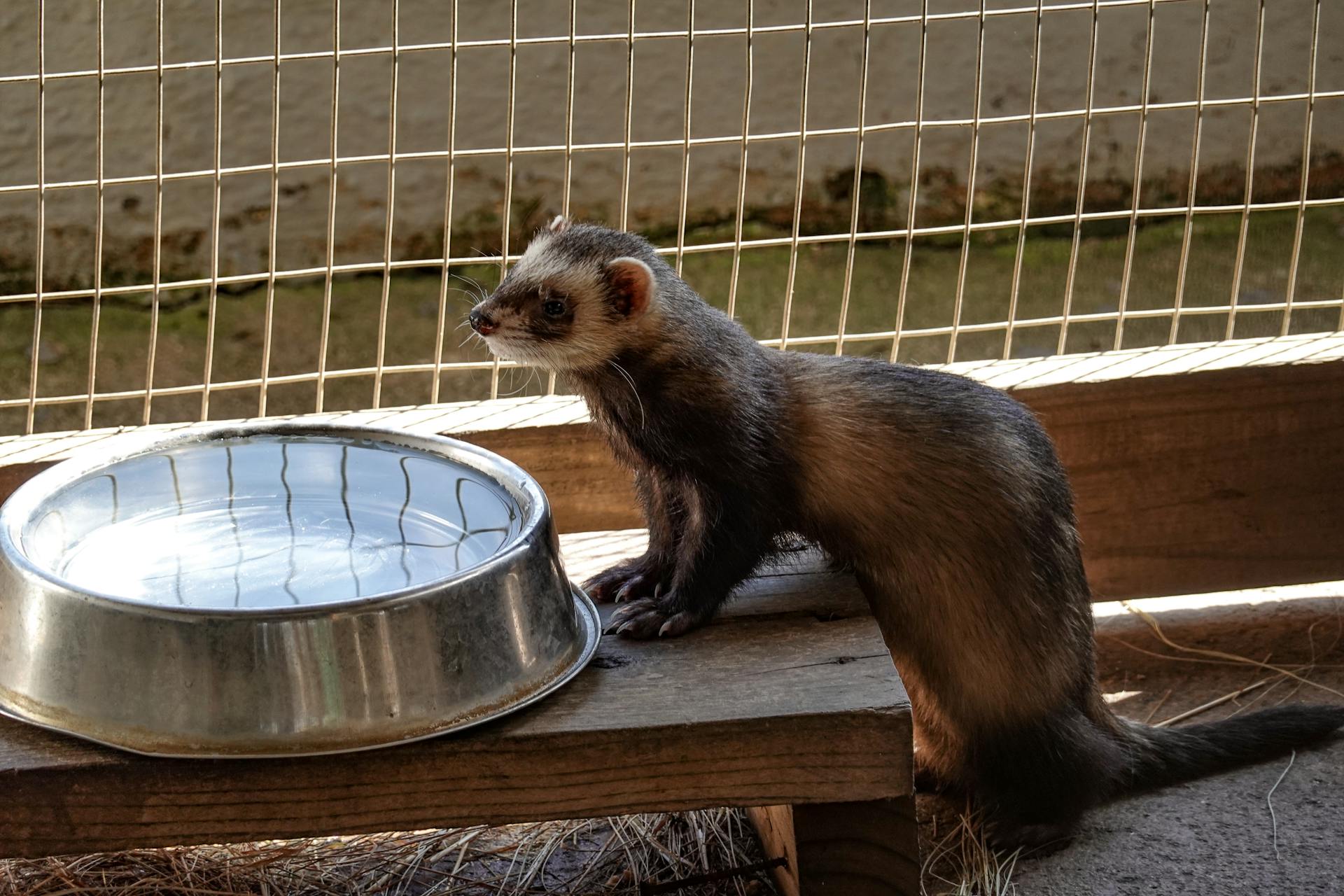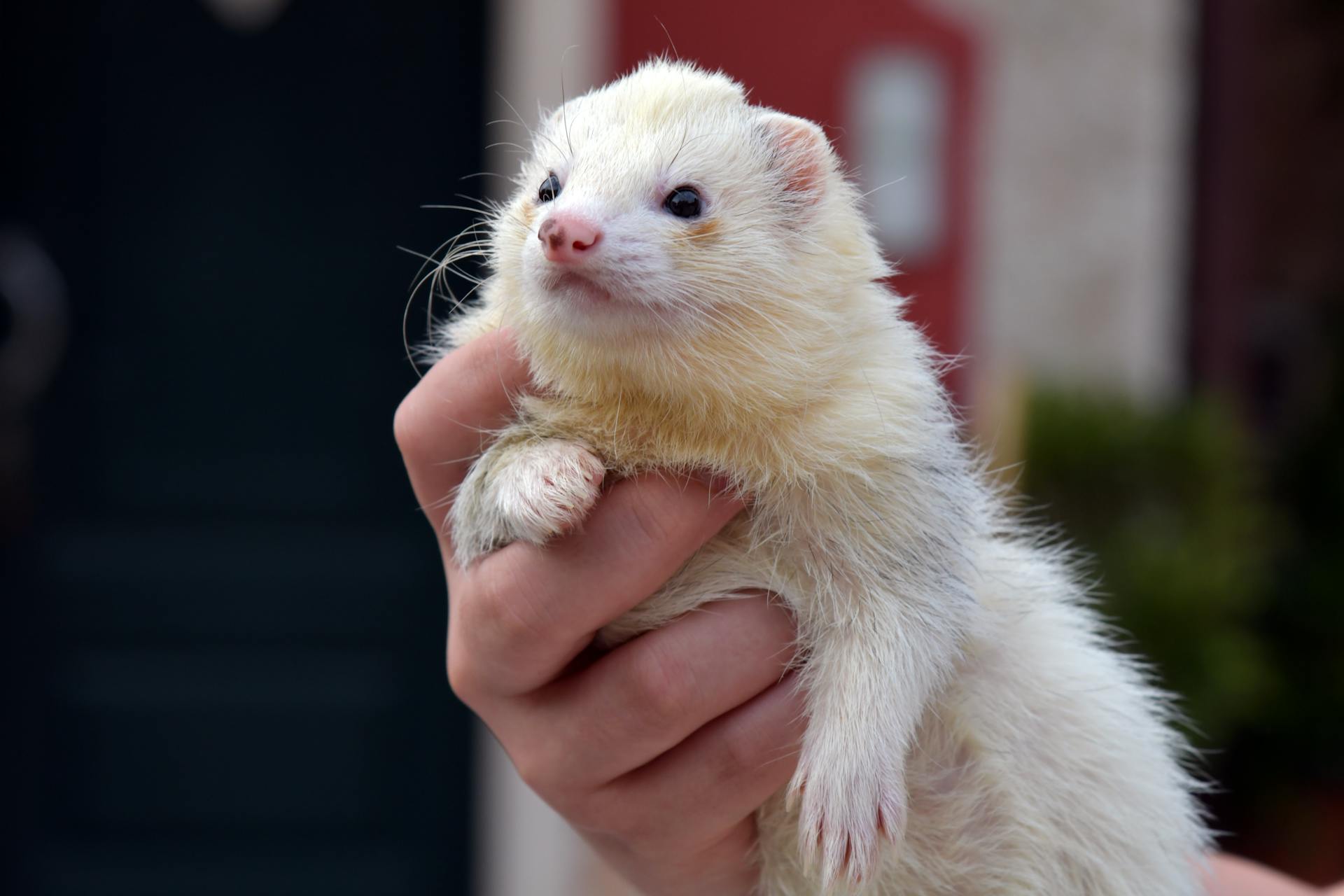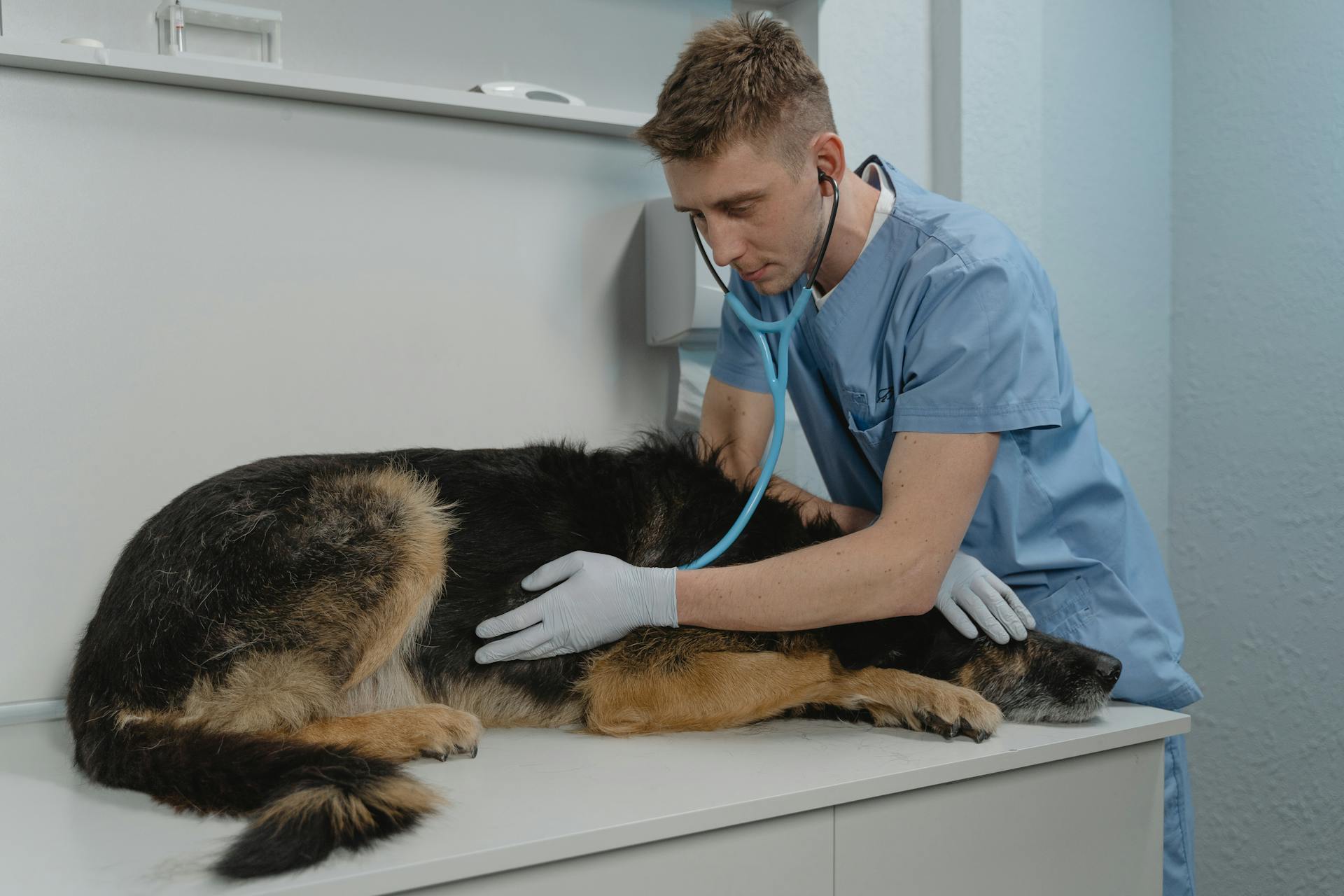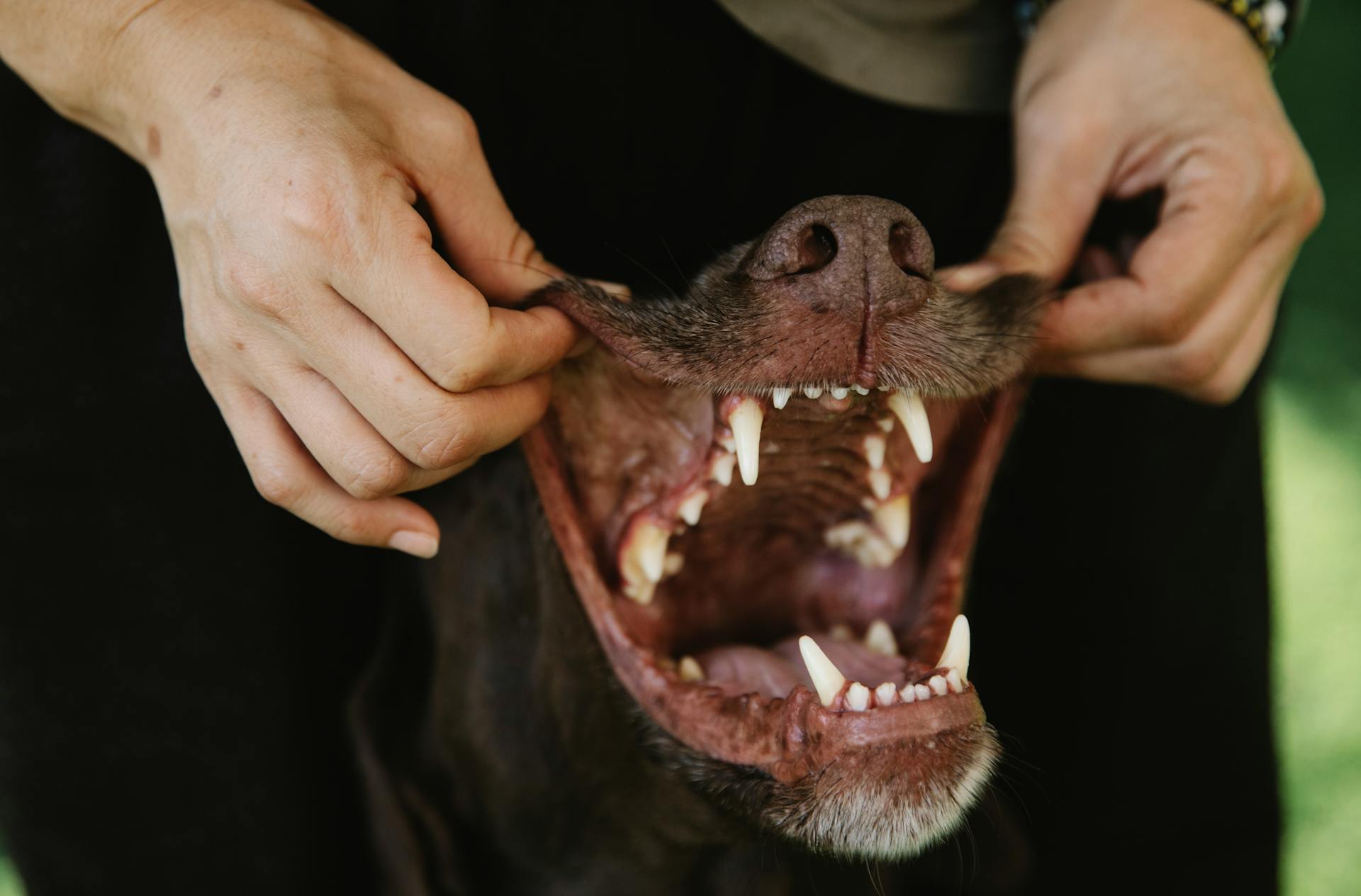
Ferret distemper is a serious and potentially life-threatening disease that affects ferrets.
Distemper is caused by a virus that attacks the ferret's respiratory, gastrointestinal, and nervous systems.
Ferrets are highly susceptible to distemper because their immune systems are not strong enough to fight off the virus.
Symptoms of distemper can appear within 7-14 days of exposure and include runny eyes, sneezing, and a lack of appetite.
If left untreated, distemper can lead to seizures, paralysis, and even death.
Early detection and treatment are crucial in preventing the spread of the disease and saving the ferret's life.
You might enjoy: Canine Distemper Virus
What Is Ferret Distemper?
Ferret distemper is a serious and often fatal disease that affects ferrets.
It's caused by a virus that attacks the ferret's respiratory, gastrointestinal, and nervous systems.
Causes and Risk Factors
Ferret distemper is a serious disease that can affect our furry friends, and understanding the causes and risk factors is crucial in preventing it. Non-immunized ferrets are at risk for disease if exposed to CDV-infected dogs or wild carnivores.
If your ferret hasn't been vaccinated, it's essential to keep them away from potential sources of infection. This includes other dogs, especially those that might be carrying the disease.
Ferrets that haven't been immunized are more susceptible to ferret distemper, making vaccination a vital part of their health care.
Here are some key risk factors to be aware of:
- Non-immunized ferrets
- Exposure to CDV-infected dogs or wild carnivores
Diagnosis and Treatment
Diagnosing ferret distemper can be challenging, but veterinarians use a combination of history, clinical signs, and diagnostic tests to confirm the disease. Abnormal hematologic findings include lymphopenia, thrombocytopenia, and regenerative anemia.
Immunocytochemistry, fluorescent antibody testing, and smears from the epithelial lining of various tissues can be used to detect inclusions in cells. Diagnostic imaging of the thorax shows an interstitial lung pattern in the early phase.
Supportive care with IV fluids and antibiotics for secondary bacterial infections is provided after culture and sensitivity testing. Humane euthanasia is recommended in diagnosed patients with severe clinical signs, as the reported mortality rate in ferrets is 100%.
Preventive vaccination is the most successful treatment of the disease, and veterinarians recommend the Purevax Ferret Distemper Vaccine. Two subcutaneous injections of 1mL at 3-week intervals are given, followed by annual revaccination with a single 1mL dose.
Readers also liked: Pitbull Dog Signs
Diagnosis

Diagnosis is a crucial step in determining if your ferret has contracted distemper. A diagnosis can be challenging and is based on history, clinical signs, and results of diagnostic tests.
Abnormal hematologic findings consist of lymphopenia, thrombocytopenia, and regenerative anemia. In the early phase, distemper inclusions can be found in small numbers in circulating lymphocytes.
Diagnostic imaging of the thorax shows an interstitial lung pattern in the initial phase. An alveolar lung pattern has been described with secondary bacterial infection.
Immunocytochemistry can be performed, and submitted samples should contain cells from the conjunctival, tonsillar, genital, and respiratory epithelia. This special stain can also be used on cells in cerebrospinal fluid, blood (buffy coat), urine sediment, and bone marrow.
Cerebrospinal fluid taps should be performed in patients with neurologic signs. Cytological changes depend on the stage of infection, and a false-negative result can always occur in the early stages of the disease.
Expand your knowledge: Difference between Kennel Cough and Upper Respiratory Infection

Immunohistochemistry of tissue biopsies of the upper respiratory tract and the associated lymphatic system, as well as skin biopsies are diagnostic. Serum antibody titers can be evaluated by using a neutralization test.
Postmortem findings show classic acidophilic inclusion bodies in the cytoplasm of epithelial cells of the mucous membranes, reticulum cells, leukocytes, glia, and neurons.
Timecourse
Understanding the timecourse of Canine Distemper Virus (CDV) infection is crucial for effective diagnosis and treatment.
Shedding begins about 7 days after exposure to the virus, which is a critical period for preventing the spread of the disease.
The infection can be divided into two phases: a catarrhal phase, which typically occurs 7-10 days post-infection, and a CNS phase, which may or may not be preceded by the catarrhal phase.
Death from ferret strains of CDV occurs in 12-16 days, highlighting the importance of prompt treatment and care.
Here's a summary of the timecourse of CDV infection:
- Shedding begins about 7 days after exposure
- CDV has a catarrhal phase (7-10 days post-infection)
- Death from ferret strains of CDV occurs in 12-16 days
Preventing Pet Illnesse
Vaccination is the most successful treatment of ferret distemper, and it's essential to get your ferret vaccinated as soon as possible.
Preventive vaccination with Purevax Ferret Distemper Vaccine is available in the United States, and it's a lyophilized vaccine of a recombinant canarypox vector expressing HA and F glycoproteins of canine distemper virus.
Ferret breeders generally give the first shot when the kits are 6-8 weeks old, and the last two shots are usually given by your veterinarian at 12 and 16 weeks of age.
You can also consider getting your ferret vaccinated more frequently if they will be exposed to young, unvaccinated dogs or ferrets or under chronic stress.
However, over-vaccination can cause health problems, so it's essential to consult with your veterinarian to determine the best vaccination schedule for your ferret.
In fact, one veterinarian believes that yearly distemper vaccination boosters are unnecessary and counterproductive, and recommends vaccinating every 3-4 years.
Additional reading: Canine Distemper Vaccine Side Effects
If your ferret shows even the slightest post-vaccination reactions, it's best not to vaccinate them again.
It's also worth noting that if Purevax is not available, some veterinarians have successfully used Nobivac Puppy-DPv, a vaccine not approved for use in ferrets in the USA, but used successfully in Europe and the UK.
See what others are reading: How to Train a Ferret Not to Bite?
Frequently Asked Questions
Can a ferret survive distemper?
Ferrets are highly susceptible to canine distemper and typically do not survive the illness. Unfortunately, the disease is almost always fatal in ferrets.
What are the clinical signs of distemper in ferrets?
Ferrets with distemper may exhibit symptoms such as ocular and nasal discharge, anorexia, diarrhea, and skin rashes. These symptoms can progress to more severe issues like immunosuppression and seizures if left untreated.
Can ferrets get canine distemper?
Yes, ferrets are highly susceptible to canine distemper, which is almost always fatal if they contract the virus. However, vaccination can effectively protect them from infection.
Sources
- https://todaysveterinarypractice.com/exotic-medicine/ferret-distemper/
- https://vetmed.tamu.edu/news/pet-talk/ferret-distemper/
- https://vetspace.2ndchance.info/all-about-distemper-in-ferrets/
- https://aemv.org/newsletter/ferret-distemper-spotlight/
- https://www.vetlexicon.com/exotis/ferrets/microbiology/articles/canine-distemper/
Featured Images: pexels.com


